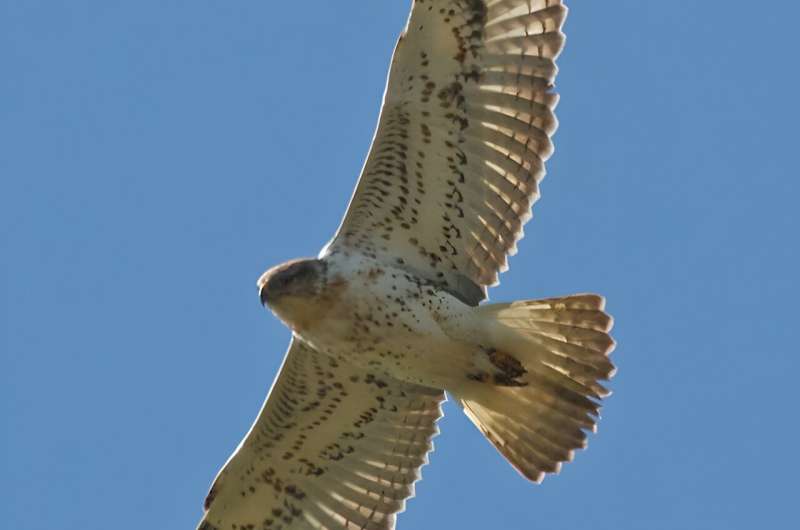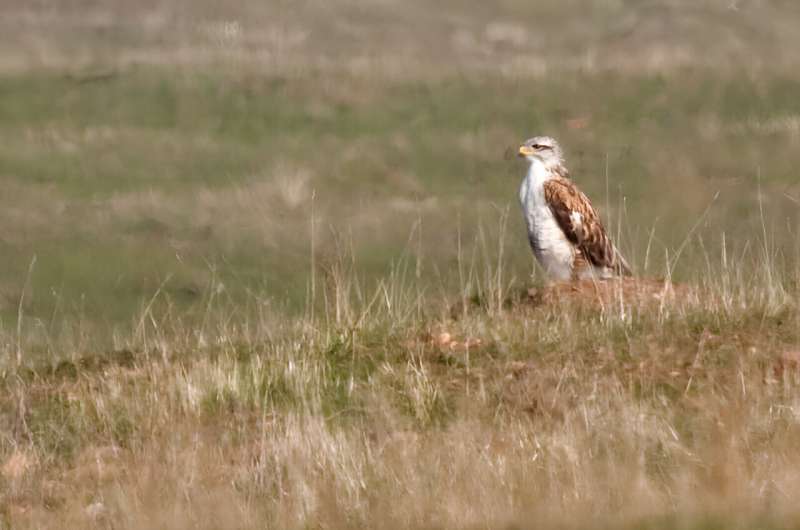This article has been reviewed according to Science X's editorial process and policies. Editors have highlighted the following attributes while ensuring the content's credibility:
fact-checked
proofread
Hawk defies expectations in the face of habitat decline

Ferruginous Hawks (Buteo regalis) that spend their winters in California seem to be going up in number, yet their preferred grassland habitat has been declining for over 20 years. Most other grassland bird species are, sadly, doing the expected: plummeting in tandem with the open areas that used to define much more of western North America.
In their new paper "Population Trends of the Ferruginous Hawk (Buteo regalis) Wintering in California," published in the Journal of Raptor Research, lead author Edward Pandolfino and co-authors Lily Douglas from the U.S Fish and Wildlife Service and Chris Ray of The Institute for Bird Populations, propose potential reasons for the hawks' surprising population trend.
Their study shows how citizen science can illuminate unexpected realities occurring on raptor wintering grounds, a part of their annual cycle that receives less attention than the breeding season yet carries important implications for species health.
Ferruginous Hawks can be challenging to study. They don't show up reliably at migration count sites because they don't concentrate along predictable topographical features (e.g. ridges) like many other migratory hawks. Population data on the species is contradictory in many places, and as a result, their conservation status varies between states, regions, and even countries. Many of the individuals wintering in California breed in Washington or Oregon, where they are listed as endangered and sensitive-critical, respectively.

To investigate this inconsistent picture of how the species is faring, Pandolfino and his team analyzed a citizen science dataset from the Washington-Oregon cohort's wintering grounds. They looked at five Bird Conservation Areas in California for which Christmas Bird Counts (CBCs) had been conducted from 1998 through 2022.
CBCs are run voluntarily by birders and bird-affiliated organizations using a consistent protocol to obtain data on the presence of bird species each December. These counts provide a more robust collection of data points for Ferruginous Hawk presence in a core part of their range than would be obtainable by a research team operating under typical project parameters.
The team's analysis revealed that although habitat quality decreased significantly over the 25-year period, Ferruginous Hawks increased in winter abundance during that same period across California. This was an unexpected finding, especially because the species has declined in Washington where many of these same individual hawks raise their chicks.

As Pandolfino puts it, "Grassland species are nearly all in long-term, continent-wide declines. Our findings offer a small ray of hope these hawks can continue to persist."
One possible explanation for their resilience in California is that Ferruginous Hawks prefer larger prey compared to raptors sharing the same habitat, including Black-tailed Jackrabbits (Lepus californicus), which thrive in open habitats including some impacted by development and agriculture. It is also possible that Ferruginous Hawks have learned to take advantage of inactive croplands as a new habitat source, and/or have expanded their diet to include a wider diversity of prey species.
Whatever the reason for the hawks' apparent increase in the face of habitat reduction, these findings indicate that the population dynamics of open-habitat raptors can be unexpectedly complex. Because Ferruginous Hawk youngsters experience high rates of mortality during their first year, knowing what happens to hawks from different age classes on their nonbreeding grounds, and protecting those places, is crucial to the species' success. In California, this means a collaborative approach, and an integrated conservation ideology.

"Nearly every acre of Ferruginous Hawk habitat surveyed for this paper is on private cattle ranches," says Pandolofino. "In California, the survival of this hawk is completely dependent on cattle ranching continuing to be a viable way to make a living."
As top predators, raptors like the Ferruginous Hawk indicate the health of their surrounding environment which, in today's changing world, is a trait to acknowledge. Pandolfino hopes to continue aiding grassland birds like the Ferruginous Hawk through his research in California and educate the public about the importance of their dwindling preferred habitat.
More information: Edward R. Pandolfino et al, Population Trends of the Ferruginous Hawk (Buteo regalis) Wintering in California, Journal of Raptor Research (2024). DOI: 10.3356/jrr2370
Provided by Raptor Research Foundation




















